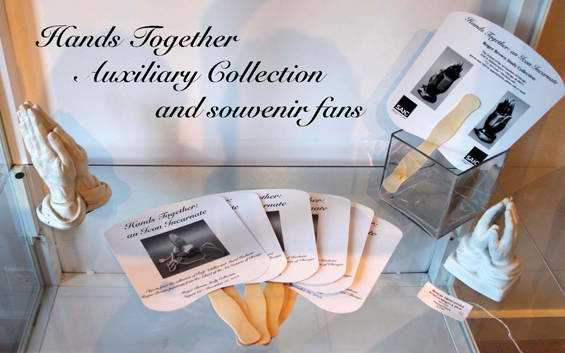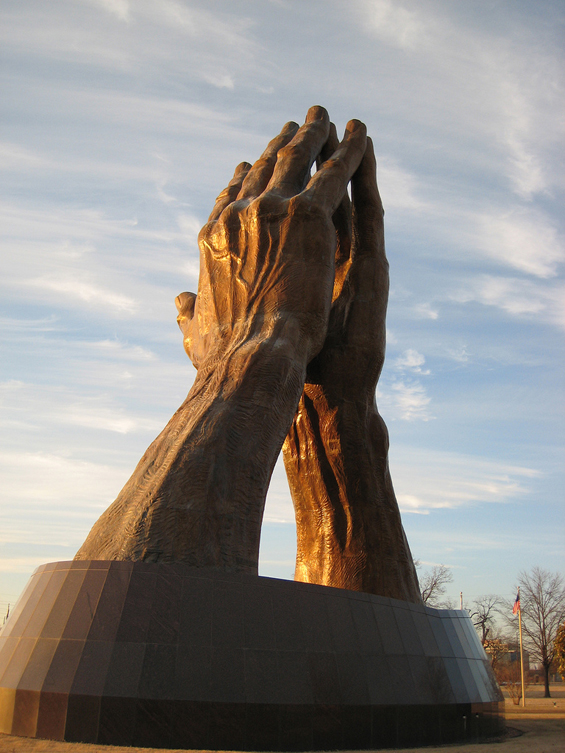Hands Together: An Icon Incarnate
Wednesday, October 23rd, 2013 » By lstone » See more posts from Happening Now at the RBSC
Hands Together: An Icon Incarnate
A modest exhibition at the Roger Brown Study Collection
August 26 – December 16, 2013
In 1508 Albrecht Dürer highlighted with white paint a black ink brush drawing of two hands, palm to palm, on handmade paper tinted a very uniform blue. It was a study for an apostle’s hands for his Heller Altarpiece. This study of his left hand as seen in two mirrors evolved into an iconic image of prayer.
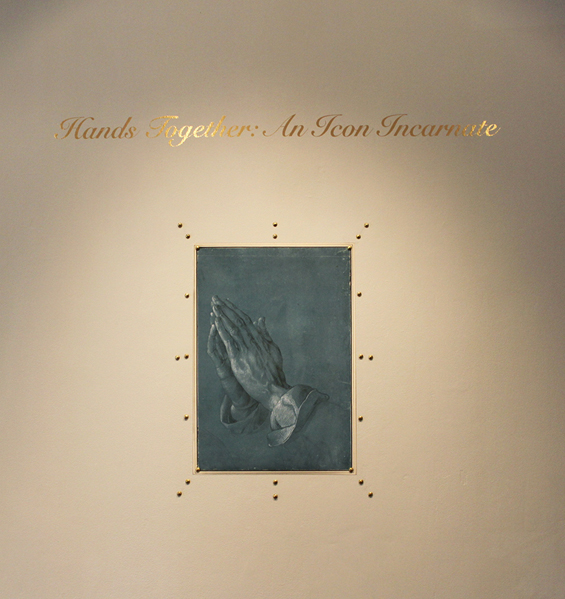 Reproduction: study for Apostle’s hands, also known as “Praying Hands” 1508, brush, gray and white ink, gray wash on blue prepared paper, 29.1 x 19.7 cm. Original drawing in the collection of the Albertina, Vienna. Reproduced with permission on banner material, 23 x 16 inches.
Reproduction: study for Apostle’s hands, also known as “Praying Hands” 1508, brush, gray and white ink, gray wash on blue prepared paper, 29.1 x 19.7 cm. Original drawing in the collection of the Albertina, Vienna. Reproduced with permission on banner material, 23 x 16 inches.
In 1871, after many years of being preserved in the Albertina, Dürer’s sketch was shown to the public for the first time. No one paid any particular attention. Twenty-five years later, in 1896, the sketch was reproduced for the first time. The Praying Hands image became an immediate sensation and reproductions by scores of printers found a wall-spot in many German homes.
This new domestic image quickly spread to the United States, brought by many thousands of German immigrants. By the mid-1950s the study sketch from 1508 shows up in 3-D as cast plaster, candles, bookends, lamp stands and is claimed as a symbol by Baptists and Fundamentalist Christians.
 Detail view, praying hands objects at the RBSC.
Detail view, praying hands objects at the RBSC.
This display of some 50 objects from the collection of Rolf Achilles and Maral Hashemi reflects Dürer’s hands in the hands of an adoring public. Through it we celebrate the conversation between “fine art” and objects from popular culture––generally considered “not-so-fine-art”–– brought together on neutral ground.
 Rolf Achilles and Hands Together
Rolf Achilles and Hands Together
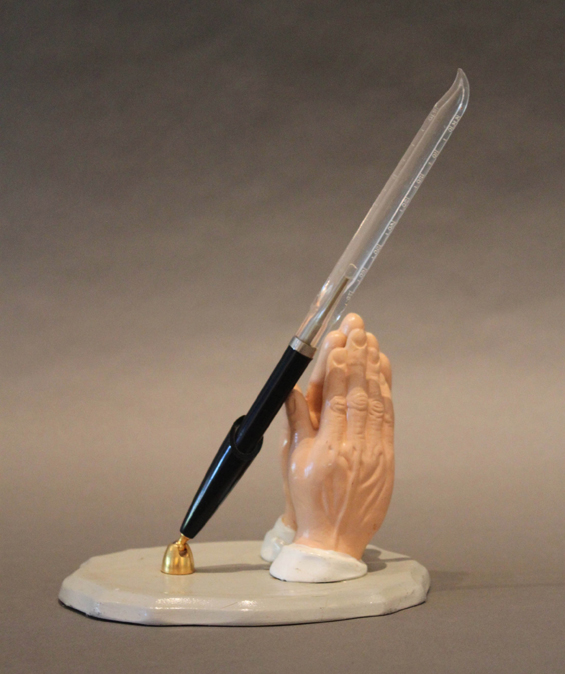 Pen holder, artist & date unknown; plaster, paint, metal, and plastic
Pen holder, artist & date unknown; plaster, paint, metal, and plastic
 Pencil sharpener, artist & date unknown; plastic
Pencil sharpener, artist & date unknown; plastic
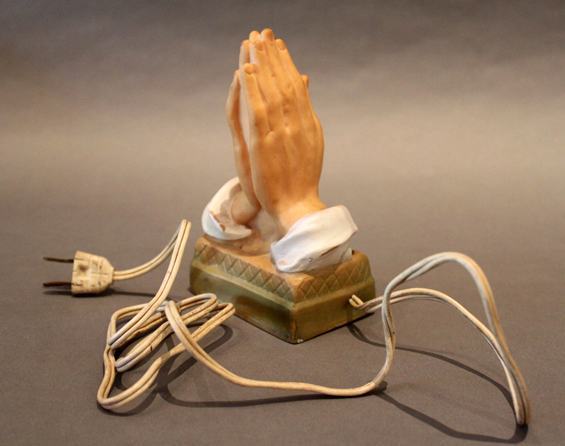 Night light, artist & date unknown; cast rubber, paint, electric cord and bulb
Night light, artist & date unknown; cast rubber, paint, electric cord and bulb
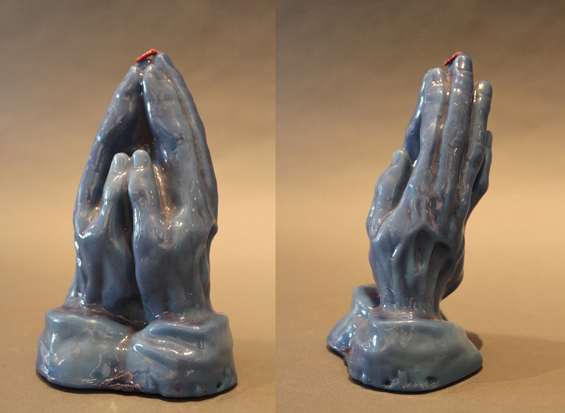 Candle, Paraffinalia Fine Candles, IX 89, wax, paper label, wick.
Candle, Paraffinalia Fine Candles, IX 89, wax, paper label, wick.
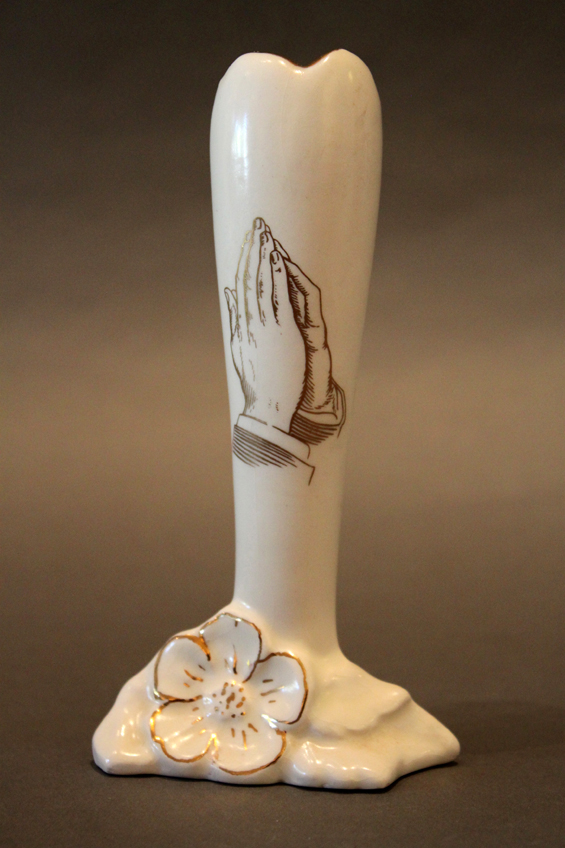 Bud vase, artist & date unknown; cast porcelain, glaze and decal.
Bud vase, artist & date unknown; cast porcelain, glaze and decal.
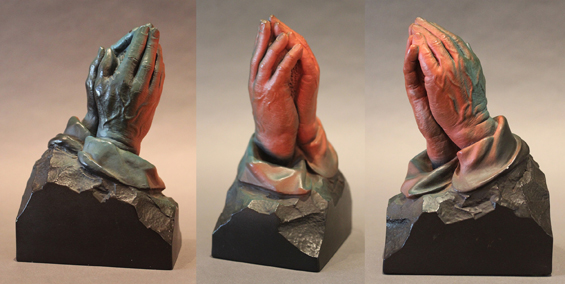 Praying Hands by Victor © Creative Arts, Inc. Date unknown, cast resin.
Praying Hands by Victor © Creative Arts, Inc. Date unknown, cast resin.
 Collapsible cup, “If any man thirst let him come unto me,” date unknown, Made in Hong Kong, plastic and paint.
Collapsible cup, “If any man thirst let him come unto me,” date unknown, Made in Hong Kong, plastic and paint.
 Praying hands statue, © 1989 922 Universal Statuary, cast resin, paint, felt, and paper labels. Made in USA.
Praying hands statue, © 1989 922 Universal Statuary, cast resin, paint, felt, and paper labels. Made in USA.
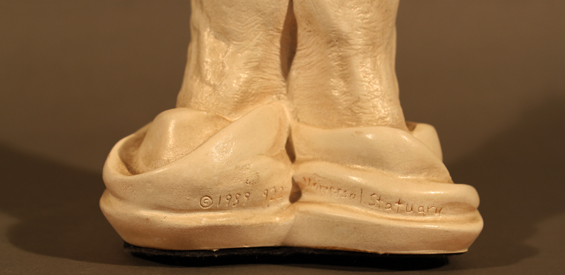 Detail, Praying hands statue base (white), © 1989 922 Universal Statuary, cast resin, paint, felt, and paper labels.
Detail, Praying hands statue base (white), © 1989 922 Universal Statuary, cast resin, paint, felt, and paper labels.
Made in USA.
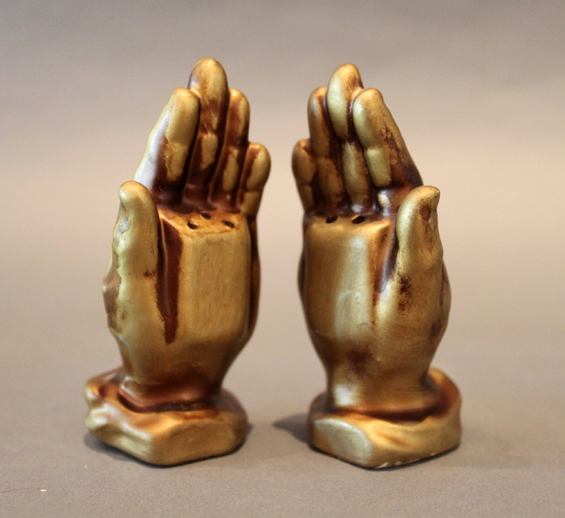 Salt and pepper shakers, artist & date unknown, slip cast ceramic and paint, plastic stoppers.
Salt and pepper shakers, artist & date unknown, slip cast ceramic and paint, plastic stoppers.
A display cabinet contains praying hands objects discovered and acquired by RBSC staff and friends, plus our souvenir fans (quite affordable at $2.00@).
Hands Together is augmented by three Roger Brown paintings from SAIC’s collection each reflecting Brown’s engagement with religion, representation, popular culture, issues of scale, and the many dimensions of faith.
In Brown’s The Story of Creation he updates Giovanni de Paolo’s iconic composition to 1989, with Kenny Rogers as God. Brown riffs on the idea that a Western, Christian God has been envisioned as an older white man with gray/white hair and beard, and that popular entertainers are elevated to supreme status in our culture.
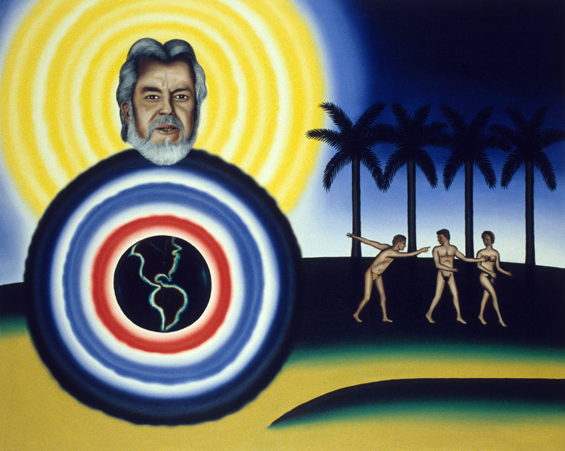 Roger Brown, The Story of Creation, 1989, oil on canvas, 48 x 60 in.
Roger Brown, The Story of Creation, 1989, oil on canvas, 48 x 60 in.
© The School of the Art Institute of Chicago and the Brown family.
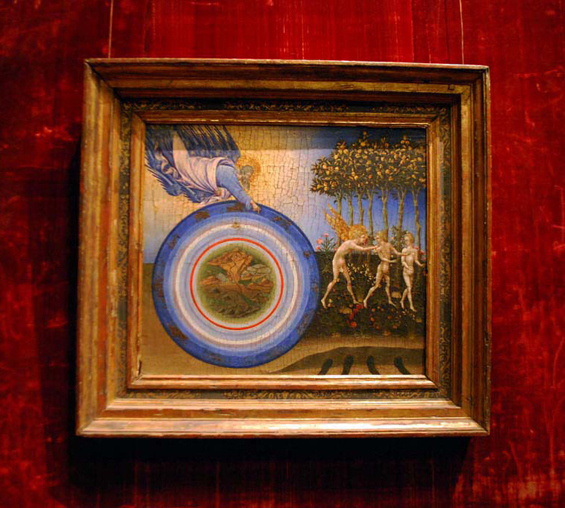 Giovanni di Paolo, The Creation of the World and the Expulsion from Paradise, 1445, Tempera and gold on wood, 18 1/4 x 20 1/2 in. (46.4 x 52.1 cm) Metropolitan Museum, New York, Robert Lehman Collection. Photo: Lisa Stone
Giovanni di Paolo, The Creation of the World and the Expulsion from Paradise, 1445, Tempera and gold on wood, 18 1/4 x 20 1/2 in. (46.4 x 52.1 cm) Metropolitan Museum, New York, Robert Lehman Collection. Photo: Lisa Stone
Veronica’s Landscape has long been a puzzler: why would Brown interpret Veronica’s veil as a landscape? (In the legend, Veronica wiped Christ’s face as he made his way to the crucifixion; his image was mystically transferred to the cloth, a ‘true icon.’) The portrait of Jesus is strikingly similar to an object Brown had in his La Conchita, California home, a slip-cast ceramic oval with what we come to recognize as the face of Jesus recessed in a concavity. This object––whose eyes appear to follow the moving observer–– may have been so oddly compelling that Brown just had to paint it.
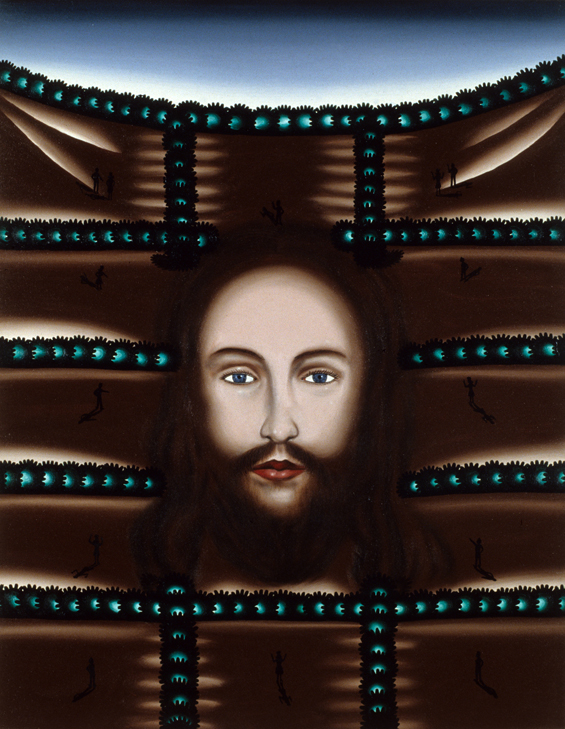 Roger Brown, Veronica’s Landscape, 1988, oil on canvas, 36 x 28 in.
Roger Brown, Veronica’s Landscape, 1988, oil on canvas, 36 x 28 in.
© The School of the Art Institute of Chicago and the Brown family.
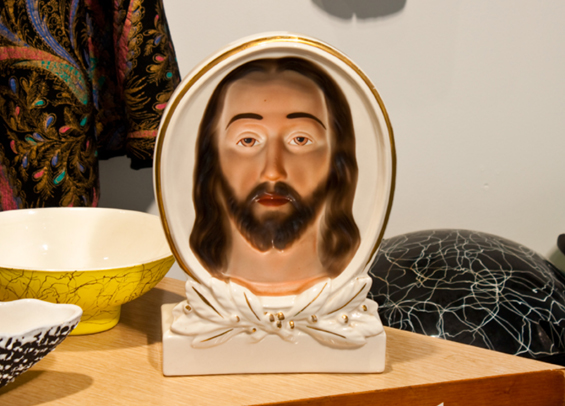 Artist unknown, concave portrait, “Jesus,” slip cast ceramic, glaze and paint. SAIC’s Roger Brown/La Conchita, CA Collection.
Artist unknown, concave portrait, “Jesus,” slip cast ceramic, glaze and paint. SAIC’s Roger Brown/La Conchita, CA Collection.
Virtual Still Life #16: 3 Saki Cups and Four Big Sur Communion Chalices With Oral Roberts Vision Of A Two Mile High Jesus, presents issues of scale in evangelizing. Oral Roberts indeed had a vision of a towering Jesus, which hit the newspapers and tabloids as a sensation. Brown created a very phallic interpretation of Roberts’ vision in 1984.
 Roger Brown, Oral Roberts Vision of a Two Mile High Jesus. 1984, oil on canvas, 72 x 48 inches.
Roger Brown, Oral Roberts Vision of a Two Mile High Jesus. 1984, oil on canvas, 72 x 48 inches.
© The School of the Art Institute of Chicago and the Brown family.
There is a praying hands tie in here: Oral Roberts did indeed commission a 60 foot tall bronze casting of praying hands for his City of Faith in Tulsa, OK.
In 1995 Brown returned to the subject, placing the viewer, facing the vision of Jesus, point blank at two miles high in a sickly haze. Ordinary yet extraordinary ceremonial vessels ground the ground plane. Are we in heaven?
 Roger Brown, Virtual Still Life #16: 3 Saki Cups and Four Big Sur Communion Chalices With Oral Roberts Vision Of A Two Mile High Jesus, 1995, oil on canvas and mixed media, 29 ½ x 23 ½ x 9 in.
Roger Brown, Virtual Still Life #16: 3 Saki Cups and Four Big Sur Communion Chalices With Oral Roberts Vision Of A Two Mile High Jesus, 1995, oil on canvas and mixed media, 29 ½ x 23 ½ x 9 in.
© The School of the Art Institute of Chicago and the Brown family.
Hands Together inaugurates occasional exhibitions from faculty and staff collections, and the ongoing investigation of objects at the RBSC. We are open by appointment, please come have a look.
Rolf Achilles and Lisa Stone

